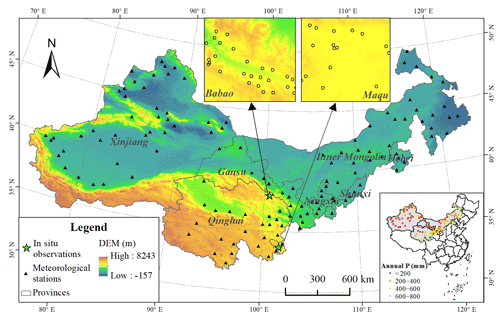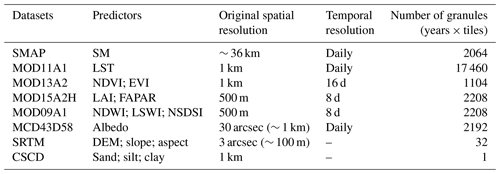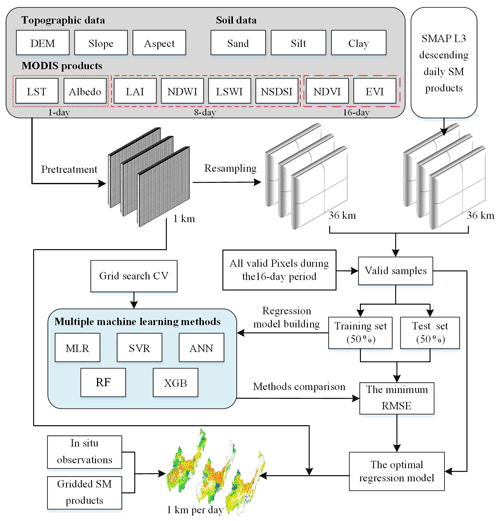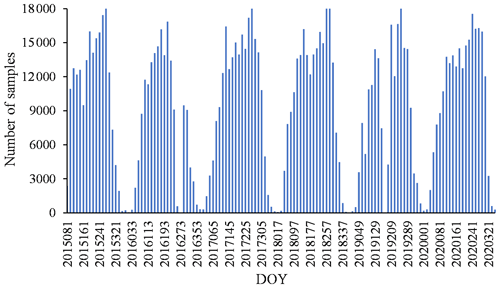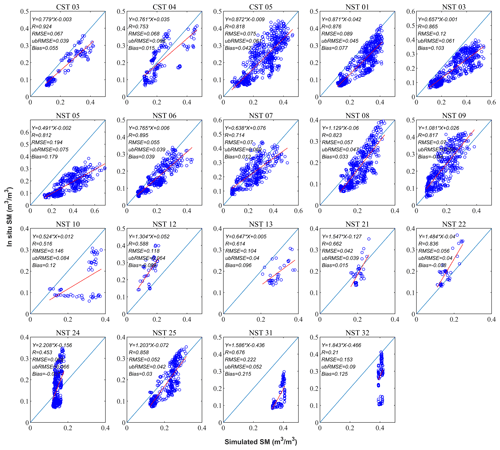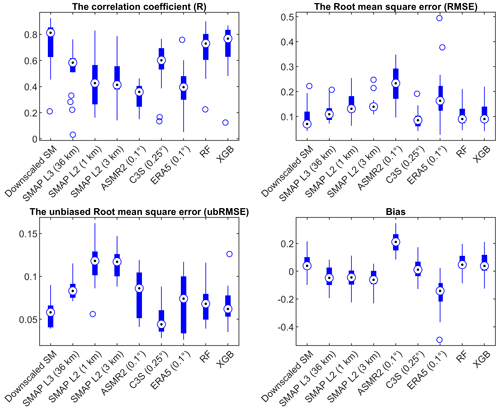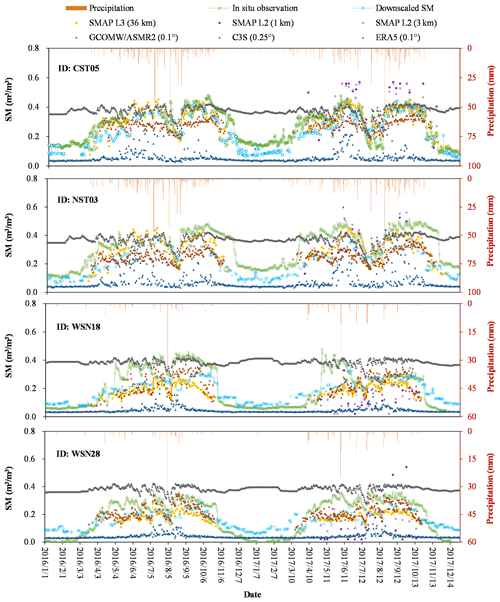the Creative Commons Attribution 4.0 License.
the Creative Commons Attribution 4.0 License.
Daily soil moisture mapping at 1 km resolution based on SMAP data for desertification areas in northern China
Pinzeng Rao
Yicheng Wang
Fang Wang
Yang Liu
Xiaoya Wang
Zhu Wang
Land surface soil moisture (SM) plays a critical role in hydrological processes and terrestrial ecosystems in desertification areas. Passive microwave remote-sensing products such as the Soil Moisture Active Passive (SMAP) satellite have been shown to monitor surface soil water well. However, the coarse spatial resolution and lack of full coverage of these products greatly limit their application in areas undergoing desertification. In order to overcome these limitations, a combination of multiple machine learning methods, including multiple linear regression (MLR), support vector regression (SVR), artificial neural networks (ANNs), random forest (RF) and extreme gradient boosting (XGB), have been applied to downscale the 36 km SMAP SM products and produce higher-spatial-resolution SM data based on related surface variables, such as vegetation index and surface temperature. Desertification areas in northern China, which are sensitive to SM, were selected as the study area, and the downscaled SM with a resolution of 1 km on a daily scale from 2015 to 2020 was produced. The results showed a good performance compared with in situ observed SM data, with an average unbiased root mean square error value of 0.057 m3 m−3. In addition, their time series were consistent with precipitation and performed better than common gridded SM products. The data can be used to assess soil drought and provide a reference for reversing desertification in the study area. This dataset is freely available at https://doi.org/10.6084/m9.figshare.16430478.v6 (Rao et al., 2022).
- Article
(10595 KB) - Full-text XML
-
Supplement
(1029 KB) - BibTeX
- EndNote
Surface soil moisture (SM) plays a very important role in water–energy cycle processes (Sandholt et al., 2002; De Santis et al., 2021) and is an important source of water for plants and soil microbes (Wang et al., 2007; Gu et al., 2008; Mallick et al., 2009). Large-scale areas of northern China are undergoing desertification because of scarce precipitation and insufficient SM. The accurate acquisition of SM is valuable to ecological conservation and revegetation in arid areas of northern China.
In the past, SM data were mainly obtained through ground measurements or the assimilation of products based on land surface models such as the Global Land Data Assimilation System (GLDAS) (Fang and Lakshmi, 2014; Zawadzki and Kędzior, 2016; Liu et al., 2021). Although most accurate SM data at different soil depths can be obtained, field measurements and in situ observations are limited due to the high cost and labor intensity involved in their collection and are generally not representative of soil water status over larger areas (Rahimzadeh-Bajgiran et al., 2013; Zhao et al., 2018; Bai et al., 2019). With the development of remote-sensing technologies, continuous SM estimates can be generated at regional and global scales (Peng et al., 2021). Compared to ground measurements, remote-sensing products can provide good spatial and temporal coverage of SM with a relatively low cost to the user (Zeng et al., 2015; Zhao et al., 2018; Meng et al., 2021). Data assimilation SM products largely depend on the accuracy of the land surface model and the original inputs (Zawadzki and Kędzior, 2016). They generally have low accuracy in areas where ground measurements are scarce, which is a problem that can be overcome with remote sensing.
At present, there are many remotely sensed SM data, some of which are from microwave remote-sensing satellites, including active and passive types. SM retrievals from active sensors like Synthetic Aperture Radar (SAR) are sensitive to scattering and greatly affected by the surface roughness and vegetation types (Lievens et al., 2011; Wagner et al., 2013). Unlike active sensors, passive microwave radiometers or sensors are rarely affected by scattering (Abbaszadeh et al., 2019). Common passive microwave SM products are listed in Table 1 below. Studies have compared these products and found that Soil Moisture Active Passive (SMAP) SM products have higher accuracy and robustness than other remotely sensed SM products (Liu et al., 2019; Wang et al., 2021).
Passive microwave SM products have been applied at watershed and national scale (Fang and Lakshmi, 2014; Meng et al., 2021). However, due to their coarse spatial resolution, microwave SM products have limited applicability to small-scale areas. Compared to microwave sensors, optical satellites such as MODIS and Landsat have a finer spatial resolution. Some observations generated from optical satellites provide good information about SM, such as vegetation index (VI) (usually Normalized Difference Vegetation Index (NDVI) or Enhanced Vegetation Index (EVI)) and land surface temperature (LST) (Wang et al., 2007; Sun et al., 2012). Many experiments have tried to use these two parameters from optical remote sensing to retrieve surface SM (Mallick et al., 2009; Fang et al., 2013). Based on the LST and VI triangle space, Sandholt et al. (2002) proposed the temperature vegetation dryness index (TVDI) and used it to assess the SM status. Relative SM indicators can be calculated using optical remote-sensing data; however, reliable ground measurements or other data are still required to obtain the true value of SM.
Some studies have tried to use surface variables from optical observations to improve the spatial resolution of passive remotely sensed SM products (Peng et al., 2017). Zhao et al. (2017) used the triangle method and Landsat satellite observations to disaggregate coarse-resolution SM data. Studies have shown that polynomial regression is effective in SM and optical observations (Zhao and Li, 2013; Piles et al., 2016). However, these methods have shortcomings in representing the nonlinear relationship between SM and other surface variables (Zhao et al., 2018; Hu et al., 2020). Machine learning methods can be applied to show the nonlinear relationships between SM and surface variables. Random forest (RF) and artificial neural network (ANN) methods have been widely used in previous studies due to their high generalization ability and robustness (Yao et al., 2017; Liu et al., 2020; Demarchi et al., 2020; Chen et al., 2021). Chen et al. (2021) developed the global surface SM dataset covering 2003–2018 at 0.1∘ resolution with neural networks and some related variables. Im et al. (2016) used machine learning approaches (RF, boosted regression trees, and Cubist) to downscale AMSR-E SM data in South Korea and Australia and found RF to be superior to the other downscaling methods. Although these machine learning methods perform well in constructing nonlinear regression models, there are still some shortcomings. For example, neural networks are prone to overfitting when the sampling is inefficient (Piotrowski and Napiorkowski, 2013) or variables that are weakly correlated with the dependent variable (Elshorbagy and Parasuraman, 2008; Ågren et al., 2021). Since the RF algorithm uses random sampling with replacement, its simulation results will not exceed the range of training set and tend to ignore some extreme values when used as a regression model (Belgiu and Drăguţ, 2016). Additionally, it does not perform well when learning from an extremely imbalanced training data (Lin et al., 2021). Extreme gradient boosting (XGB), as a new ensemble learning method (Chen and Guestrin, 2016), performs well in some fields (Wang et al., 2020; Fan et al., 2021; Ma et al., 2021), but it has rarely been used for soil moisture downscaling. Compared with methods such as RF, the XGB algorithm adopts the boosting weighted sampling method, which can reduce the impact of imbalanced data and better simulate the extreme values existing in the samples (Chen and Guestrin, 2016). The coarse-resolution remote sensed SM (> 10 km) itself has ignored some maxima or minima with relatively finer-grid SM, so a method that better simulates extreme values will obviously have certain theoretical advantages.
The selection of feature variables is critical for regression models. In addition to LST and VI mentioned above, variables such as terrain and soil conditions also have a significant impact on SM. Abbaszadeh et al. (2019) downscaled SMAP radiometer SM products over the continental United States using MODIS products (including NDVI and LST) and precipitation and topographic data and evaluated the influence of soil texture on SM. Zhao et al. (2018) added additional surface variables, such as leaf area index (LAI), normalized difference water index (NDWI), surface albedo and the solar zenith angle. Hu et al. (2020) added the normalized shortwave-infrared difference bare soil moisture index (NSDSI), horizontally polarized brightness temperature (TBh) and vertically polarized brightness temperature (TBv) to the regression model. In general, all these variables can be classified into vegetation, temperature, soil wetness, topography and soil factors and sensors conditions.
In recent years, the Chinese government has carried out afforestation activities in order to reverse desertification in the north. Considering the role of SM in terrestrial ecosystems, it is urgent to obtain accurate SM with high temporal and spatial resolution. This study aims to downscale SMAP SM products by constructing a nonlinear relationship between SM and related surface variables by means of multiple machine learning methods and generate SM products with higher temporal and spatial resolution in desertification areas. The in situ observed SM data from the Maqu monitoring network and Babao monitoring network, several gridded SM products, and precipitation and temperature data from meteorological stations were used for validation and analysis.
2.1 Study area
Northern China is mostly arid with an annual precipitation of generally less than 600 mm and is subject to large-scale desertification. The desert areas of northern China are susceptible to climate and hydrological changes and have fragile ecosystems. Soil water is a key parameter in land–atmosphere interactions (Ma et al., 2019), and its change greatly affects the survival of vegetation and agricultural production in desertification areas. The studied area whose boundaries are provided by government departments used for this study covers 3.36×106 km2, encompassing seven provinces (Fig. 1). The precipitation in the study area decreases gradually from southeast to northwest and belongs to the temperate continental climate (Fig. 1). The terrain is complex, and the average elevation is approximately 1900 m, ranging from −192 to 7439 m.
2.2 Observations for the production of soil moisture data
2.2.1 SMAP SM data
The SMAP satellite was launched on 31 January 2015. Its mission consists of an L-band radar and radiometer instrument suite, which provides global measurements and monitoring of SM in the top 5 cm of soil. The Level-3 products are daily composites of the Level-2 products and are the most commonly used for applications. The Level-3 products are available in three spatial resolutions: 36 km passive, 9 km active–passive and 3 km active (O'Neill et al., 2010). Following the malfunctioning of its radar in 2015, SMAP radar data were replaced with those of Sentinel-1, limiting the application of active and active–passive products.
The SMAP Level-3 passive daily SM product (L3_SM_P, Version 6) with a grid resolution of 36 km has been produced since 31 March 2015. Zeng et al. (2015) showed that most remotely sensed SM products were slightly better during daytime than during nighttime, and the same conclusion for the SMAP SM product was confirmed by Zhao et al. (2018). Therefore, the SMAP Level-3 SM product with the descending overpass time of 06:00 was used in this study. The data were downloaded from NASA Earthdata (https://search.earthdata.nasa.gov, last access: 17 May 2021).
2.2.2 MODIS products
MODIS provides continuous time-series predictors for important parameters, such as vegetation index and surface temperature. This paper used MODIS products MOD09A1, MOD11A1, MOD13A2, MOD15A2H and MCD43D58 (Table 2). The 1 km daily LST was provided by MOD11A1, and the 1 km 16 d EVI and NDVI was provided by MOD13A2. MOD15A2H provided 8 d leaf area index (LAI) with a spatial resolution of 500 m. MCD43D58 provided daily albedo data with a spatial resolution of 30 arcsec (∼ 1000 m). Some soil-wetness-related indexes, including the NDWI, NSDSI and Land Surface Water Index (LSWI), were produced by MOD09A1. Their formulas are
where B2, B4, B6 and B7 represent the MOD09A1 surface reflectance of the second, fourth, sixth and seventh bands, respectively.
These MODIS products are available from NASA Earthdata (https://search.earthdata.nasa.gov, last access: 20 February 2021). All data were obtained from 2015 to 2020 and processed to a spatial resolution of 1000 m.
2.2.3 Topographic data
Topographic factors are strongly related to SM, including elevation, slope and aspect (Bai et al., 2019; De Santis et al., 2021). The Shuttle Radar Topography Mission (SRTM) digital elevation model (DEM) at 3 arcsec resolution (∼ 100 m), version 3, obtained from the Land Processes Distributed Active Archive Center (LP DAAC) (https://lpdaac.usgs.gov/products/srtmgl3v003/, last access: 16 January 2021), was used as elevation. Slope and aspect were generated based on the DEM.
2.2.4 Soil texture data
Soil texture, the proportions of sand, silt and clay particles, controls the water-holding capacity of the soil. The soil data at 1000 m resolution, including the proportions of sand, silt and clay, used for this study used the China Soil Characteristics Dataset (CSCD) (Shangguan et al., 2012), obtained from the National Tibetan Plateau Data Center (https://data.tpdc.ac.cn/en/, last access: 3 January 2021).
2.2.5 In situ SM observations
The in situ SM measurements were collected from the data provided by the Maqu monitoring network (Zhang et al., 2021) and the Babao monitoring network (Kang et al., 2017). The Maqu monitoring network covers 26 sites and provides SM for the surface layer (0–5 cm) at 15 min intervals from 2009 to 2019; 19 of the available sites which have data after 2015 were used in this study (Fig. 1). The Babao monitoring network covers 40 sites and provides hourly SM for the surface layer (4, 10 and 20 cm) from 2013 to 2017; 29 of the available sites have data after 2015, and their observations of the first layer (4 cm) were used in this study (Fig. 1). For comparison with the simulated results, they were all processed into daily time series.
2.2.6 Precipitation and temperature data
The daily precipitation and temperature data were acquired from 131 meteorological stations from the China Meteorological Data Service Centre (http://data.cma.cn, last access: 29 July 2021). The spatial locations of these meteorological stations are shown in Fig. 1. The average annual precipitation of most stations from 2015 to 2020 is less than 600 mm and gradually decreases from northwest to southeast (Fig. 1).
2.2.7 Other gridded SM datasets
Some other gridded SM data were used to compare the simulation results (Table 3). The SMAP Level-2 product (L2_SM_SP) merges SMAP radiometer and processed Sentinel-1A/1B SAR observations. It is available at 3 and 1 km resolution. The Global Change Observation Mission Water (GCOM-W1) AMSR2 product is produced by the Japan Aerospace Exploration Agency (JAXA), and SM data at a 0.1∘ spatial resolution were selected for this study. The Copernicus Climate Change Service (C3S) produces a global SM gridded dataset from 1978 to present from satellite sensors such as SMOS, AMSR2 and SMAP. It has a spatial resolution of 0.25∘ and offers three types of products: active, passive and combined. The combined product that we used in this study is generated by merging the active and passive products. The fifth generation reanalysis dataset (ERA5) produced by European Centre for Medium-Range Weather Forecasts (ECMWF) provides several variables including volumetric soil water over several decades. In this dataset, the soil is divided into four layers, and the depth of the top layer is 0–7 cm. In this study, we downloaded the hourly volumetric soil water data of the top layer and processed them as daily averages. Famine Early Warning Systems Network (FEWS NET) Land Data Assimilation System (FLDAS) provides daily SM at a 0.01∘ spatial resolution over the Central Asia region (30–100∘ E, 21–56∘ N), which covers part of our study area. The product consists of four layers of SM, and the SM at the top layer (0–10 cm) was selected for this study.
2.3 Downscaling approach based on multi-machine learning
According to the selected variable indicators (mainly including topographic data, soil data and some MODIS products) and machine learning methods, we constructed a framework to downscale SMAP SM based on multiple machine learning methods (Fig. 2).
2.3.1 Machine learning methods
Machine learning methods are widely used in regression and classification. We selected machine learning methods that are currently widely used to build regression models for SM and its related variables. We studied five methods: multiple linear regression (MLR), support vector regression (SVR), ANNs, random forest (RF) and extreme gradient boosting (XGB). MLR and SVR have been widely used as regression methods in the past (Yu et al., 2012; Achieng, 2019; Wang et al., 2019). ANN is currently one of the most popular machine learning methods and is used in many fields, including the inversion of remotely sensed SM (Del Frate et al., 2003; Elshorbagy and Parasuraman, 2008; Yao et al., 2017; Chen et al., 2021).
RF and XGB are tree-based ensemble algorithms, which have prediction accuracy and good generalization ability and are not prone to overfitting (Rao et al., 2018; Abbaszadeh et al., 2019). RF is a multiple-tree algorithm improved by bootstrap to reduce decision tree bias in determining the splits. Several studies have used RF to build regression models of remotely sensed SM and related variables, and almost all achieved better results compared to other regression methods (Zhao et al., 2018; Qu et al., 2019; Hu et al., 2020). In contrast, the application of XGB, which applies a regularized gradient boosting framework, is still very limited. However, XGB has prominent advantages in generalization performance and accuracy (Wang et al., 2020).
The XGB algorithm is a boosting-type ensemble of multiple CART decision trees (Chen and Guestrin, 2016). The predicted result of the boosting-type tree ensemble model can be expressed as follows:
where F is the space of regression tree, K is the total number of trees, which means the model uses K additive functions, and fk(xi) is the weighted score of the kth tree on ith input data (xi).
XGB adopts a regularized learning objective to optimize the simulation results.
where l is the loss function, N is the total number of input and Ω is the regularization term to penalize the model complexity and prevent overfitting.
Compared with RF and other some methods, XGB has significantly faster calculation speed (Fan et al., 2018; Shi et al., 2021). Some studies have shown that XGB is a better regression and classification algorithm than RF and other machine learning methods (Ågren et al., 2021; Fan et al., 2021).
2.3.2 The construction of 16 d regression model
The downscaling process is shown in Fig. 2. First, all data need to be preprocessed. Daily LST data are likely to be affected by the cloud, so we performed quality control to MOD11A1 products using its quality control (QC) band and choose high-quality cloud-free pixels. All selected variables, including LST, albedo, LAI, NDWI, LSWI, NSDSI, NDVI, EVI, DEM, slope, aspect, sand, silt and clay, were aggregated into a resolution of 1 km with a GeoTIFF format. These variables were further resampled to the spatial resolution of the SMAP SM data (36 km) using the nearest-neighbor interpolation method.
Second, valid samples were obtained and split. Since it is severely affected by noise (such as clouds), MOD11A1 only provides daily valid clear-sky LST values onto grids. In addition, each SMAP image has a narrow coverage and provides only a small number of valid pixels per day. It means that there may be few or no valid samples if only the data of a certain day are selected to build the regression. The variables from MOD13A2 and MOD15A2H are the best composite within 16 and 8 d, respectively. To overcome the limitation, we chose to build regression models within 16 d periods (the lowest temporal resolution from these dynamic variables). All valid data (including training and test sets) within 16 d were used as the samples in the regression model. For instance, for NDVI and EVI on 1 January 2020, which are composite results from 1 to 15 January, the valid data during the period were used as samples. The number of valid samples for surface variables and SMAP SM for each period in 2015–2020 is shown in Fig. 3. The day of year (DOY) is used to represent the corresponding period. Since there are limited available SMAP SM grid data, there may be few valid samples we can obtain during cold seasons. The valid samples for each period were divided into training and test sets, each accounting for 50 % of the total number of samples. In this study, stratified random sampling based on sampling date during the 16 d period was employed to split the training and test sets. Moreover, to avoid excessively inconsistent training and test sets, the Kolmogorov–Smirnov (KS) test is adopted to test the distribution consistency of them (Kovalev and Utkin, 2020). If the p value of the KS test result is less than or equal to 0.05, stratified random sampling is performed again and until the requirements are met.
Third, the regression model was determined based on training and test sets. Considering the number of samples is critical to the accuracy of the regression model, we only selected periods with more than 100 samples to build the model and DOY of 2016017, 2018017, 2018353, 2019001 and 2019177 were excluded. Then, we used the training set and multiple machine learning methods (MLR, SVR, ANN, RF and XGB) to build a regression model for each 16 d period. The regression model was then defined according to the selected machine learning method:
where f represents the regression function of the machine learning method (MLR, SVR, ANN, RF or XGB).
Finally, hyperparameters are turned, and the optimal model is selected. Hyperparameters are critical for some machine learning methods (Klein et al., 2017; Khan et al., 2020; Sun et al., 2021). In this study, the key hyperparameters of SVR, ANN, RF and XGB are tuned based on grid search cross-validation (CV). All models are evaluated based on the correlation coefficient (R) and the root mean square error (RMSE). They are calculated as follows:
where SMI is the SMAP SM, SMP is the corresponding SM predicted by the regression model, Cov represents the covariance function, Var is the variance and n is the number of valid samples for SMI or SMP.
The RMSE is used as the evaluation metric for hyperparameter tuning. The tuning results of hyperparameters are shown in Tables S2 and S3 in the Supplement. According to the optimal hyperparameter, the corresponding model can be constructed.
2.3.3 Prediction of the 1 km daily SM product
The accuracy of the five regression models was compared using the average RMSE of training and test sets. This average RMSE can be expressed as
where RMSETraining and RMSETest are the RMSE of training and test sets for these models, respectively.
The regression model with the smallest was selected as the optimal model. Furthermore, we used the selected optimal model and these surface variables with a resolution of 1 km within 16 d to simulate daily SM at 1 km resolution on the corresponding date. Taking 16 d as a period, all daily SM data with a spatial resolution of 1 km from 2015 to 2020 were predicted. In addition, to obtain a more complete time series of SM data, we used the model of the previous period when the number of valid samples was less than 100.
2.4 Evaluation method
The in situ SM measurements were used to validate the downscaled results. In addition to R and RMSE, bias and unbiased RMSE (ubRMSE) were also used for accuracy evaluation. Bias indicates the overall level of overestimation or underestimation of simulation results. ubRMSE can eliminate the influence of deviation. They were calculated according to
where SMIn is the in situ observed SM, SMD is the downscaled SM of the corresponding grid and n is the number of valid samples for SMIn or SMD.
3.1 Model comparison
The daily SM data from DOY 81 in 2015 to DOY 366 in 2020 were simulated producing 128 regression results every 16 d. The correlation coefficient (R) and the root mean square error (RMSE) of each regression result for the training set and the test set are shown in Figs. 4 and 5, respectively. According to Eq. (9), among the 128 regression results, there were 114 from the XGB model and 14 from RF.
For all models except MLR, R is greater than 0.6, and RMSE is less than 0.05 m3 m−3 both for training and test sets. R values greater than 0.6 and 0.8 indicate reliable and strong correlations, respectively (Akoglu, 2018). It means that all methods except MLR have reliable simulation accuracy. For the training set using XGB, Rs are all above 0.96, generally higher than for other methods; similarly, the RMSEs of XGB are all lower than 0.02 m3 m−3, generally lower than those of other methods. The R of RF is second only to that of XGB, and for several periods it is higher than for XGB; the RMSEs of RF are also generally lower than 0.02 m3 m−3 and are lower than those of XGB in several periods. SVR and ANN perform generally better in the cold season and worse in other seasons. In general, their results are inferior to those of XGB and RF. The simulation results of MLR are relatively poor both in terms of RMSE and R.
The results of the test set show that XGB, RF and SVR perform better than ANN and MLR. Table 4 shows the average RMSE and R values of the training and test sets over all periods, and the performance order of the model can be obtained as XGB > RF > SVR > ANN > MLR. In addition, there are seasonal variations in R and RMSE both for training and test sets. Moreover, the evaluation accuracy is generally better in the cold season, when sample sizes are relatively small.
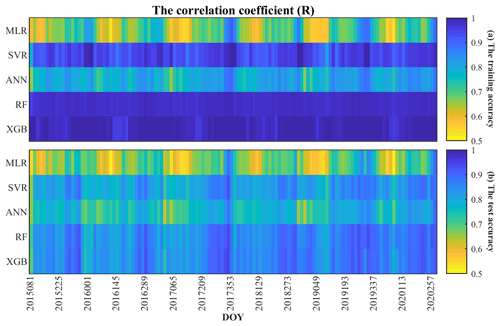
Figure 4The correlation coefficient (R) of the models (MLR, SVR, ANN, RF and XGB) on different periods: (a) the training accuracy and (b) the test accuracy.
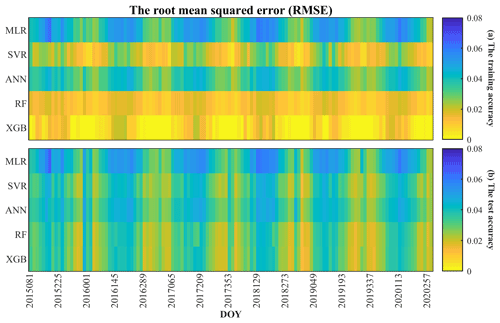
Figure 5The root mean square error (RMSE) of the models (MLR, SVR, ANN, RF and XGB) for different periods: (a) the training accuracy and (b) the test accuracy.
3.2 Comparison with the in situ data and precipitation
The downscaled 1 km gridded SM were compared with the in situ SM observations of the Maqu network and Babao network (Fig. 6). Due to the difference in sensors, soil depth and measurement scale (point observation in case of the in situ measured SM and 1 km grid for the downscaled SM), there is a certain deviation between in situ observation data and the downscaled gridded SM data. The downscaled SM of most sites at the Maqu network and Babao network is highly correlated with the in situ measured SM (R> 0.6). In the Maqu network, the ubRMSEs with an average of 0.057 m3 m−3 are all less than 0.090 m3 m−3, and the bias ranges from −0.10 to 0.22 m3 m−3. In the Babao network, the average ubRMSE of all sites is 0.081 m3 m−3, and some of them exceed 0.1 m3 m−3. In addition, their bias ranges from −0.07 to 0.45 m3 m−3. It means that the validation accuracy of the Babao network is generally lower than that of the Maqu network. That may be mainly because the measured soil depth at the Babao network is 4 cm, which means that there could be a systematic error between the datasets. Therefore, the validation accuracy should mainly refer to the evaluation accuracy of the Maqu network.
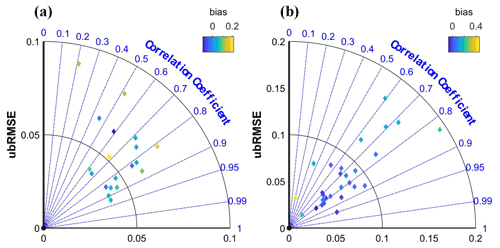
Figure 6The relationships between in situ SM and downscaled SM. (a) Maqu network and (b) Babao network.
To better understand the reason for these poor results, scatter plots comparing the two sets of data were drawn. Figure 7 shows the results of the 19 sites of the Maqu network. All four statistical metrics, namely R, RMSE, ubRMSE and bias, were calculated, and their fitting line of the scatter was plotted. Not surprisingly, the relationship is generally improved where there are more valid data. It means that the validation effect of in situ observations is affected by the amount of data. The same conclusion can be drawn through 29 sites at the Babao network (Fig. S1 in the Supplement).
All SM products are compared with in situ SM. Figure 8 shows a significantly higher correlation between the downscaled SM and in situ SM of the Maqu network. The median ubRMSE of the downscaled SM is the smallest, and its RMSE is second only to the C3S (0.25∘) product. The bias of the downscaled SM is higher than that of some products, even higher than the original SMAP L3 (36 km) data. Almost the same results can be obtained from in situ observations of the Babao network (Fig. S2). The difference is that the bias of the downscaled SM is lower than the result of SMAP L3 (36 km). Compared with the RF-based and the XGB-based downscaled SM, the downscaled SM with multiple machine learning approaches performed better, especially R and ubRMSE.
The observed SM of sites with a greater number of observed data were compared with these gridded SM data at different resolutions and precipitation. Figure 9 shows the temporal variations of these SM at four sites 2016–2017. The relationship between in situ observed SM and precipitation at all four sites is very consistent, showing annual fluctuation. The greater SM corresponds to more precipitation during the hot season, and the smaller SM corresponds to less precipitation during the cold season.
Except for GCOMW/ASMR2 SM, the variation trends of these acquired gridded SM and the downscaled SM are basically the same despite the large difference in spatial resolution. GCOMW/ASMR2 significantly underestimates SM compared to other products. Both the SMAP L2 SM at 1 and 3 km may be overestimated (CST05) and may also be underestimated (WSN18) compared with in situ observations. Moreover, SMAP L2 SM has some valid data mainly on hot days and almost no valid data during cold seasons. The peak values of the ERA5 SM are close to those of the in situ observations, but the low values are overestimated. The C3S SM is similar to the 36 km SMAP SM, and its peak values are simulated more accurately, while the minimum values have little valid data. Compared with the original data (36 km SMAP L3), the downscaled SM has a more complete time series, especially during the cold season. The downscaled SM data almost all match well with the in situ measured SM data, and all of them are consistent with the precipitation. The difference between the downscaled SM and the in situ measured SM is mainly reflected in the magnitude of the variation, which is probably due to the difference in spatial resolution.
3.3 Mapping of the downscaled SM
SM varies greatly in different months in desertified areas. Figure 10 shows the average SM in each month in the study area. The SM shows a monthly change pattern, and the values from June to September are bigger than in other months, especially in southern Qinghai Province, eastern Inner Mongolia Province, and western Xinjiang Province. The SM in some areas is low throughout the year, such as in the Tarim Basin of Xinjiang Province, western Inner Mongolia Province and most of Gansu Province.
The annual average SM was calculated (Fig. S3). Compared with the monthly average SM, the annual average SM changed significantly less. Further, we compared the spatial patterns of the downscaled SM with the gridded SM products with different resolutions. Figure 11 shows the daily average SM of these products from 2015 to 2020. The spatial patterns of the downscaled SM and 36 km SMAP SM are basically consistent, but the downscaled data show better details in some areas such as near rivers. The overall values of GCOMW SM are relatively small and exhibit some obvious errors in some areas. For example, SM in the Tarim Basin is higher than in the surrounding area, which is completely inconsistent with other SM data. The spatial pattern of the C3S SM is close to the downscaled SM and the 36 km SMAP SM, but some details are not presented. For example, SM in the Hetao Plain along the Yellow River is much higher than that in its surrounding area, which can be found in the downscaled SM and the SMAP SM but not in the C3S SM. There are obvious errors in the results of ERA5. The average SM is significantly overestimated in the southern part of the study area and underestimated in some areas in the northern of the study area. The FLDAS SM has high resolution, and its overall spatial pattern is relatively consistent with the downscaled SM and 36 km SMAP SM. The difference is that the FLDAS SM is significantly larger in higher-elevation areas of the west than in other regions, which is quite different from other products. This suggests that the FLDAS SM may be overestimated in these regions. In addition, FLDAS SM does not show wetter soil along the river. The spatial patterns of the RF-based and XGB-based downscaled SM are both close to that of the downscaled SM with multiple machine learning approaches; however, the maximum SM based on RF is smaller than the results based on XGB and multi-model combination.
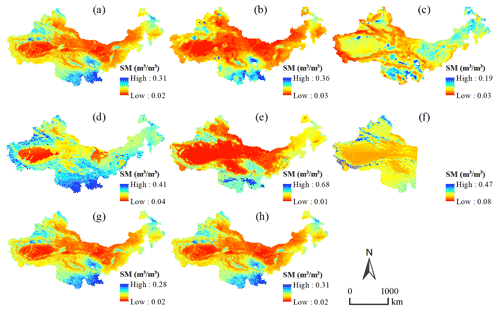
Figure 11Daily average SM from 2015–2020 in the study area. Panels (a)–(h) are the downscaled SM (1 km), SMAP L3 SM (36 km), GCOMW/ASMR2 SM (0.1∘), C3S SM (0.25∘), ERA5 SM (0.1∘), FLDAS SM (0.1∘), and RF-based and XGB-based downscaled SM (1 km), respectively.
To better demonstrate the differences in SM, a case of the Mu Us Desert was selected (Fig. 12). The Mu Us Desert is located in a semi-arid area with annual average precipitation of less than 400 mm, decreasing gradually from southeast to northwest. The main types of land cover are grassland and sandy land, and the salinization is serious in a few areas. Desertification has been severe for a long time in the past but significantly reversed with artificial afforestation in recent years.
SM shows an overall trend of gradual decrease from the southeast to the northwest (Fig. 12b–g), which is consistent with the distribution of precipitation. The average SM of the same location changes little from year to year. Overall, it is relatively large in 2018 and relatively small in 2015, which is roughly consistent with annual precipitation patterns. Land cover types also have a certain influence on the spatial difference of SM. The northwestern portion of the Mu Us Desert is mainly grassland, which is strongly dependent on precipitation (Fig. 12h). The southeastern area is mainly cultivated land and is less affected by precipitation as it relies on pumping groundwater rather than natural precipitation (Fig. 12j).
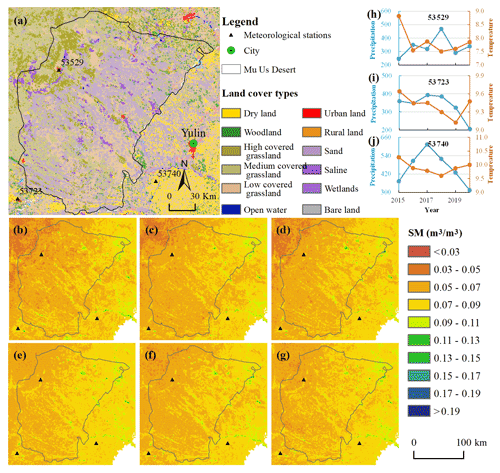
Figure 12Soil moisture estimated for the Mu Us Desert. (a) Land cover distribution over the study area; (b–g) annual average SM from 2015–2020; (h–j) annual precipitation and annual average temperature of three sites (53529, 53723 and 53740), whose surroundings are mainly grassland, cultivated land and cultivated land, respectively.
4.1 Variable importance assessment
The selection of variables is an important step of a nonlinear regression model. The importance analysis of the variables carried out for this research found that a larger number of variables can improve the regression effect of these models. Due to the variables obtained in this study coming from multiple data sources, their preprocessing may affect the construction of regression models and their relationship with SM. Moreover, variables' collinearity and hyperparameters also affect the importance relationship of variables. Figure 13 shows the average importance scores of each variable for the RF and XGB models across all available days. The importance scores of different variables in the RF-based model and the XGB-based model are similar. LST and surface albedo both affect surface energy exchange and partition. LST is an important variable in both models, which is consistent with the study of Zhao et al. (2018). NSDSI is the most sensitive soil moisture index compared to LSWI and NDWI, which was demonstrated in Yue et al. (2019). Topographical factors also exhibit importance on SM, especially elevation. NDVI is more sensitive to vegetation index than EVI and LAI. However, their effect was smaller than that of soil moisture index. It indicates that the SM inversion based only on LST and VI is inadequate. The influence of soil texture (sand, silt and clay) is relatively weak.
The standard deviation of the importance scores of each variable is shown with error bars in Fig. 13. Its changes are mainly affected by the samples used in the regression model and the temporal variations in surface variables. For static variables such as soil structure and topographic factors, the changes in their importance scores mainly depend on the number and the location of the samples. Figure 13 also shows that their standard deviation is relatively small. Compared with static variables, the standard deviation of the importance scores of dynamic variables is significantly larger, especially for LST and LAI. This indicates that it is not reliable to construct a single regression model for a long time series.
In general, the variable importance analysis suggests that the selected variables are suitable for the construction of the regression model. Moreover, choosing 16 d as a time period to build a regression model benefits from obtaining a sufficient number of samples.
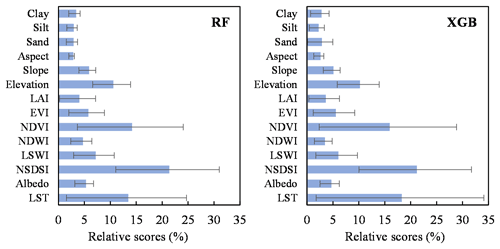
Figure 13The average importance scores of variables for the RF-based approach and XGB-based approach. Note that the importance scores are presented by increase in node purity (IncNodePurity), where the sum value is normalized for the RF model. The XGB model uses gain to reflect the weight of variables.
4.2 Advantages of model combination
Both RF and ANN have been applied to downscale remotely sensed SM so far, especially RF (Zhao et al., 2018; Qu et al., 2019; Hu et al., 2020). This study showed that the simulation results of ANN have greater uncertainty, and the accuracy is generally worse than that of RF (Figs. 4 and 5). The RF algorithm shows a good simulation ability, but in comparison, the XGB algorithm also has a corresponding effect or even higher. We also compared our simulation results combining multiple models and the RF-based simulation results. The results showed that the combined products have higher accuracy than the RF-based products, which is mainly reflected in the relatively more reasonable simulation of peaks and valleys (Table 4 and Fig. 11). MLR has the worst effect compared to the other four models, which is likely to be affected by variable collinearity. In fact, many algorithms, especially linear ones, exhibit more or less poor robustness when there is high collinearity between variables (Dormann et al., 2013; Cammarota and Pinto, 2021). However, fewer explanatory variables often mean less ability to explain target variables. Several studies have shown that ensemble tree algorithms such as RF and XGB are generally not affected by variable collinearity (Tomaschek et al., 2018; Chen et al., 2020; Feng et al., 2021).
A combination of multiple methods can reduce overfitting and uncertainties for the simulation of long time series (Zanotti et al., 2019; Yu et al., 2021). The five methods (MLR, SVR, ANN, RF and XGB) in this study have indicated the potential flaws of a single model. Although the XGB model generally performs better than other models, it still has some shortcomings. As can be seen from Figs. 4 and 5, compared with the training accuracy, the test accuracy of the XGB model is significantly reduced in several periods. This means that the simulation results of the XGB model are likely to have a certain degree of overfitting. In contrast, the difference between training and test accuracy of the RF model is smaller. It showed better stability than XGB at several periods (Figs. 4 and 5). The training accuracy of MLR and SVR has a small difference from the test accuracy, but their overall accuracy is obviously lower (Table 4), which might be due to variable collinearity. Some studies have proved that SVR may also perform better than ensemble algorithms (Yu et al., 2012; Fan et al., 2018). The fitting effect of ANN varies greatly in different periods, indicating that its generalization is lower than other models (Piotrowski and Napiorkowski, 2013). In general, the XGB and RF models provide the best combination of prediction accuracy and stability.
4.3 Analysis of the relationship with precipitation and temperature
Unlike predictors such as LST and NDVI that reflect SM status, climatic factors are key drivers of SM variability. To evaluate the impact of precipitation and temperature on SM, we performed a partial correlation analysis on the data of all meteorological stations. Figure 14 shows that SM is mainly positively correlated with precipitation and temperature, and a few regions are significantly negatively correlated with temperature. In terms of spatial distribution, SM of the sites in the eastern region (including Inner Mongolia Province, Hebei Province and Shanxi Province) is mainly significantly affected by precipitation. Due to the influence of glaciers and snowmelt, the SM of the sites in the western region (Xinjiang Province and Gansu Province) is more affected by temperature. In addition, the number of sites with significant positive correlation with precipitation and temperature is the largest in Qinghai Province. This indicates that precipitation and temperature in the eastern part of the eastern Tibetan Plateau both have a great influence on SM.
4.4 Uncertainty and prospects
While this study greatly improved the spatial resolution of SM data from 2015 to 2020 in the desertification areas of northern China by downscaling SMAP SM products, it still presents some shortcomings. Due to the influence of snow, ice and frozen ground, the number of valid SMAP pixels during cold seasons is usually small, which limits the number of available samples. With a period of 16 d, the number of valid samples may still be less than 100 during cold seasons (Fig. 3). The sample size affects the simulation accuracy. Figures 4 and 5 show that there are seasonal variations in R and RMSE, which is likely to be affected by the sample size. In general, a larger sample size often means more efficient sampling and more reliable results but not necessarily better evaluation accuracy. Likewise, insufficient samples can sometimes have good evaluation accuracy, although the results are less reliable. In order to reduce the error caused by insufficient samples, this study replaced the periods with fewer than 100 samples with the model of the previous periods. For this reason, the simulation results sometimes perform poorly during cold seasons (Fig. 9). In addition, the upscaling (from 1 to 36 km resolution) of surface variables also has a certain impact on the accuracy of the model.
Our products have a good correlation with the in situ observation data. However, in situ observed SM data are limited in their representation of the entire 1 km × 1 km grid. Figure 6 shows that the evaluation accuracy of different points varies greatly. It indicates that the relationship between in situ observation data and remote-sensing SM has great uncertainty due to the influence of scale, and the same conclusion can also be found in some related studies (Zeng et al., 2015; Abbaszadeh et al., 2019; Bai et al., 2019; Liu et al., 2019; Zhang et al., 2021). In addition, due to instrument accuracy and climate change, there are some errors in the in situ observation data, especially at low temperatures. The in situ observed SM data obtained in this paper are relatively limited, and their spatial distribution is concentrated in a certain part of the study area, which is weak representative. In order to verify the accuracy of the data as much as possible, this study also selected several sets of gridded SM products for comparison. The results showed that our products perform better in temporal variability and spatial patterns (Figs. 9 and 11).
The code mainly used in this paper mainly includes sample selection, the building of the optimal regression model and the result prediction. The downscaled daily SM dataset at 1 km spatial resolution is available at https://doi.org/10.6084/m9.figshare.16430478.v6 (Rao et al., 2022). The data maps are all provided in GeoTIFF format, and the value has been expanded 10 000 times to make them easier to store. The filenames reflect the production date in Julian Day format.
In this study, an approach was proposed for downscaling 36 km SMAP SM products using MODIS optical products and other surface variables (mainly topographic data and soil data) based on multiple machine learning methods. Overall, the regression performance of the five methods is, in order, XGB > RF > SVR > ANN > MLR. Compared with MLR, SVR and ANN, XGB and RF have much better accuracy, and they were used in combination to produce daily 1 km downscaled SM in a period of 16 d. The validation shows that the downscaled SM data are highly related to most in situ measured SM. The ubRMSE with an average of 0.057 m3 m−3 is generally less than 0.090 m3 m−3 at the Maqu network. Time series of SM data from in situ observation sites were also compared. The results show that the downscaled SM is highly related to SMAP SM and provide a more complete time series and match better with the in situ measured SM. Compared with some commonly used gridded SM products such as SMAP L2 (l km or 3 km), GCOMW/ASMR2, C3S, ERA5 and FLDAS SM, the downscaled SM data not only have higher spatial resolution, but also have a more reliable accuracy whether in time series or spatial distribution.
The maps of downscaled SM show larger values from June to September, which coincides with the vegetation growing season. The difference in annual mean SM is small. Spatially, SM is relatively large in Qinghai Province and in northeastern Inner Mongolia, especially in summer. In arid areas such as the Tarim Basin, SM is relatively small throughout the year. Moreover, precipitation and temperature both have great influence on SM in the study area. Precipitation has a greater impact on SM in the eastern part of the study area, while the effect of temperature appears to be more pronounced in the west.
This approach makes it possible to more accurately assess the soil moisture status in the study area. The results can support regional agricultural planting and revegetation efforts and can be applied to limit desertification in other areas in the future.
The supplement related to this article is available online at: https://doi.org/10.5194/essd-14-3053-2022-supplement.
FW and PR designed the research, developed the methodology, performed the analysis and wrote the paper. YW, YL, XW and ZW edited and revised the paper.
The contact author has declared that none of the authors has any competing interests.
Publisher's note: Copernicus Publications remains neutral with regard to jurisdictional claims in published maps and institutional affiliations.
We thank all data providers and the anonymous reviewers for their detailed and constructive comments.
This research has been supported by the National Key Research and Development Program of China (grant no. 2018YFC0408103), the National Pilot Project for Ecological Protection and Restoration of Mountains, Rivers, Forests, Farmlands, Lakes and Grasslands (grant no. WR0203A552018) and the Desertification Monitoring Project of National Forestry and Grass Administration (grant no. 2020062012).
This paper was edited by Martin Schultz and reviewed by two anonymous referees.
Abbaszadeh, P., Moradkhani, H., and Zhan, X.: Downscaling SMAP Radiometer Soil Moisture Over the CONUS Using an Ensemble Learning Method, Water Resour. Res., 55, 324–344, https://doi.org/10.1029/2018WR023354, 2019.
Achieng, K. O.: Modelling of soil moisture retention curve using machine learning techniques: Artificial and deep neural networks vs support vector regression models, Comput. Geosci., 133, 104320, https://doi.org/10.1016/j.cageo.2019.104320, 2019.
Ågren, A. M., Larson, J., Paul, S. S., Laudon, H., and Lidberg, W.: Use of multiple LIDAR-derived digital terrain indices and machine learning for high-resolution national-scale soil moisture mapping of the Swedish forest landscape, Geoderma, 404, 115280, https://doi.org/10.1016/j.geoderma.2021.115280, 2021.
Akoglu, H.: User's guide to correlation coefficients, Turkish J. Emerg. Med., 18, 91–93, https://doi.org/10.1016/j.tjem.2018.08.001, 2018.
Bai, J., Cui, Q., Zhang, W., and Meng, L.: An Approach for Downscaling SMAP Soil Moisture by Combining Sentinel-1 SAR and MODIS Data, Remote Sensing, 11, 2736, https://doi.org/10.3390/rs11232736, 2019.
Belgiu, M. and Drăguţ, L.: Random forest in remote sensing: A review of applications and future directions, ISPRS J. Photogramm., 114, 24–31, https://doi.org/10.1016/j.isprsjprs.2016.01.011, 2016.
Cammarota, C. and Pinto, A.: Variable selection and importance in presence of high collinearity: an application to the prediction of lean body mass from multi-frequency bioelectrical impedance, J. Appl. Stat., 48, 1644–1658, https://doi.org/10.1080/02664763.2020.1763930, 2021.
Chen, H., Chen, H., Liu, Z., Sun, X., and Zhou, R.: Analysis of Factors Affecting the Severity of Automated Vehicle Crashes Using XGBoost Model Combining POI Data, J. Adv. Transport., 2020, 1–12, https://doi.org/10.1155/2020/8881545, 2020.
Chen, T. and Guestrin, C.: XGBoost: A Scalable Tree Boosting System, in: Proceedings of the 22nd ACM SIGKDD International Conference on Knowledge Discovery and Data Mining, KDD '16: The 22nd ACM SIGKDD International Conference on Knowledge Discovery and Data Mining, San Francisco California USA, 785–794, https://doi.org/10.1145/2939672.2939785, 2016.
Chen, Y., Feng, X., and Fu, B.: An improved global remote-sensing-based surface soil moisture (RSSSM) dataset covering 2003–2018, Earth Syst. Sci. Data, 13, 1–31, https://doi.org/10.5194/essd-13-1-2021, 2021.
Del Frate, F., Ferrazzoli, P., and Schiavon, G.: Retrieving soil moisture and agricultural variables by microwave radiometry using neural networks, Remote Sens. Environ., 84, 174–183, https://doi.org/10.1016/S0034-4257(02)00105-0, 2003.
Demarchi, L., Kania, A., Ciężkowski, W., Piórkowski, H., Oświecimska-Piasko, Z., and Chormański, J.: Recursive Feature Elimination and Random Forest Classification of Natura 2000 Grasslands in Lowland River Valleys of Poland Based on Airborne Hyperspectral and LiDAR Data Fusion, Remote Sensing, 12, 1842, https://doi.org/10.3390/rs12111842, 2020.
De Santis, D., Biondi, D., Crow, W. T., Camici, S., Modanesi, S., Brocca, L., and Massari, C.: Assimilation of Satellite Soil Moisture Products for River Flow Prediction: An Extensive Experiment in Over 700 Catchments Throughout Europe, Water Res., 57, e2021WR029643, https://doi.org/10.1029/2021WR029643, 2021.
Dormann, C. F., Elith, J., Bacher, S., Buchmann, C., Carl, G., Carré, G., Marquéz, J. R. G., Gruber, B., Lafourcade, B., Leitão, P. J., Münkemüller, T., McClean, C., Osborne, P. E., Reineking, B., Schröder, B., Skidmore, A. K., Zurell, D., and Lautenbach, S.: Collinearity: a review of methods to deal with it and a simulation study evaluating their performance, Ecography, 36, 27–46, https://doi.org/10.1111/j.1600-0587.2012.07348.x, 2013.
Elshorbagy, A. and Parasuraman, K.: On the relevance of using artificial neural networks for estimating soil moisture content, J. Hydrol., 362, 1–18, https://doi.org/10.1016/j.jhydrol.2008.08.012, 2008.
Fan, J., Yue, W., Wu, L., Zhang, F., Cai, H., Wang, X., Lu, X., and Xiang, Y.: Evaluation of SVM, ELM and four tree-based ensemble models for predicting daily reference evapotranspiration using limited meteorological data in different climates of China, Agr. Forest Meteorol., 263, 225–241, https://doi.org/10.1016/j.agrformet.2018.08.019, 2018.
Fan, J., Zheng, J., Wu, L., and Zhang, F.: Estimation of daily maize transpiration using support vector machines, extreme gradient boosting, artificial and deep neural networks models, Agr. Water Manage., 245, 106547, https://doi.org/10.1016/j.agwat.2020.106547, 2021.
Fang, B. and Lakshmi, V.: Soil moisture at watershed scale: Remote sensing techniques, J. Hydrol., 516, 258–272, https://doi.org/10.1016/j.jhydrol.2013.12.008, 2014.
Fang, B., Lakshmi, V., Bindlish, R., Jackson, T. J., Cosh, M., and Basara, J.: Passive Microwave Soil Moisture Downscaling Using Vegetation Index and Skin Surface Temperature, Vadose Zone J., 12, vzj2013.05.0089er, https://doi.org/10.2136/vzj2013.05.0089er, 2013.
Feng, R., Dario, G., and Balling, N.: Imputation of missing well log data by random forest and its uncertainty analysis, Comput. Geosci., 152, 9, https://doi.org/10.1016/j.cageo.2021.104763, 2021.
Gu, Y., Hunt, E., Wardlow, B., Basara, J. B., Brown, J. F., and Verdin, J. P.: Evaluation of MODIS NDVI and NDWI for vegetation drought monitoring using Oklahoma Mesonet soil moisture data, Geophys. Res. Lett., 35, L22401, https://doi.org/10.1029/2008GL035772, 2008.
Hu, F., Wei, Z., Zhang, W., Dorjee, D., and Meng, L.: A spatial downscaling method for SMAP soil moisture through visible and shortwave-infrared remote sensing data, J. Hydrol., 590, 125360, https://doi.org/10.1016/j.jhydrol.2020.125360, 2020.
Im, J., Park, S., Rhee, J., Baik, J., and Choi, M.: Downscaling of AMSR-E soil moisture with MODIS products using machine learning approaches, Environ. Earth Sci., 75, 1120, https://doi.org/10.1007/s12665-016-5917-6, 2016.
Kang, J., Jin, R., Li, X., Ma, C., Qin, J., and Zhang, Y.: High spatio-temporal resolution mapping of soil moisture by integrating wireless sensor network observations and MODIS apparent thermal inertia in the Babao River Basin, China, Remote Sens. Environ., 191, 232–245, https://doi.org/10.1016/j.rse.2017.01.027, 2017.
Khan, F., Kanwal, S., Alamri, S., and Mumtaz, B.: Hyper-Parameter Optimization of Classifiers, Using an Artificial Immune Network and Its Application to Software Bug Prediction, 8, 11, https://doi.org/10.1109/ACCESS.2020.2968362, 2020.
Klein, A., Falkner, S., Bartels, S., Hennig, P., and Hutter, F.: Fast Bayesian Optimization of Machine Learning Hyperparameters on Large Datasets, arXiv [preprint], https://doi.org/10.48550/arXiv.1605.07079, 2017.
Kovalev, M. S. and Utkin, L. V.: A robust algorithm for explaining unreliable machine learning survival models using the Kolmogorov–Smirnov bounds, Neural Networks, 132, 1–18, https://doi.org/10.1016/j.neunet.2020.08.007, 2020.
Lievens, H., Verhoest, N. E. C., De Keyser, E., Vernieuwe, H., Matgen, P., Álvarez-Mozos, J., and De Baets, B.: Effective roughness modelling as a tool for soil moisture retrieval from C- and L-band SAR, Hydrol. Earth Syst. Sci., 15, 151–162, https://doi.org/10.5194/hess-15-151-2011, 2011.
Lin, W., Gao, J., Wang, B., and Hong, Q.: An Improved Random Forest Classifier for Imbalanced Learning, in: 2021 IEEE International Conference on Artificial Intelligence and Computer Applications (ICAICA), 2021 IEEE International Conference on Artificial Intelligence and Computer Applications (ICAICA), Dalian, China, 703–707, https://doi.org/10.1109/ICAICA52286.2021.9497933, 2021.
Liu, J., Chai, L., Lu, Z., Liu, S., Qu, Y., Geng, D., Song, Y., Guan, Y., Guo, Z., Wang, J., and Zhu, Z.: Evaluation of SMAP, SMOS-IC, FY3B, JAXA, and LPRM Soil Moisture Products over the Qinghai-Tibet Plateau and Its Surrounding Areas, Remote Sensing, 11, 792, https://doi.org/10.3390/rs11070792, 2019.
Liu, J., Chai, L., Dong, J., Zheng, D., Wigneron, J.-P., Liu, S., Zhou, J., Xu, T., Yang, S., Song, Y., Qu, Y., and Lu, Z.: Uncertainty analysis of eleven multisource soil moisture products in the third pole environment based on the three-corned hat method, Remote Sens. Environ., 255, 112225, https://doi.org/10.1016/j.rse.2020.112225, 2021.
Liu, Y., Yao, L., Jing, W., Di, L., Yang, J., and Li, Y.: Comparison of two satellite-based soil moisture reconstruction algorithms: A case study in the state of Oklahoma, USA, J. Hydrol., 590, 125406, https://doi.org/10.1016/j.jhydrol.2020.125406, 2020.
Ma, H., Zeng, J., Chen, N., Zhang, X., Cosh, M. H., and Wang, W.: Satellite surface soil moisture from SMAP, SMOS, AMSR2 and ESA CCI: A comprehensive assessment using global ground-based observations, Remote Sens. Environ., 231, 111215, https://doi.org/10.1016/j.rse.2019.111215, 2019.
Ma, M., Zhao, G., He, B., Li, Q., Dong, H., Wang, S., and Wang, Z.: XGBoost-based method for flash flood risk assessment, J. Hydrol., 598, 126382, https://doi.org/10.1016/j.jhydrol.2021.126382, 2021.
Mallick, K., Bhattacharya, B. K., and Patel, N. K.: Estimating volumetric surface moisture content for cropped soils using a soil wetness index based on surface temperature and NDVI, Agr. Forest Meteorol., 149, 1327–1342, https://doi.org/10.1016/j.agrformet.2009.03.004, 2009.
Meng, X., Mao, K., Meng, F., Shi, J., Zeng, J., Shen, X., Cui, Y., Jiang, L., and Guo, Z.: A fine-resolution soil moisture dataset for China in 2002–2018, Earth Syst. Sci. Data, 13, 3239–3261, https://doi.org/10.5194/essd-13-3239-2021, 2021.
O'Neill, P., Entekhabi, D., Njoku, E., and Kellogg, K.: The NASA Soil Moisture Active Passive (SMAP) mission: Overview, in: 2010 IEEE International Geoscience and Remote Sensing Symposium, IGARSS 2010–2010 IEEE International Geoscience and Remote Sensing Symposium, Honolulu, HI, USA, 3236–3239, https://doi.org/10.1109/IGARSS.2010.5652291, 2010.
Peng, J., Loew, A., Merlin, O., and Verhoest, N. E. C.: A review of spatial downscaling of satellite remotely sensed soil moisture: Downscale Satellite-Based Soil Moisture, Rev. Geophys., 55, 341–366, https://doi.org/10.1002/2016RG000543, 2017.
Peng, J., Albergel, C., Balenzano, A., Brocca, L., Cartus, O., Cosh, M. H., Crow, W. T., Dabrowska-Zielinska, K., Dadson, S., Davidson, M. W. J., de Rosnay, P., Dorigo, W., Gruber, A., Hagemann, S., Hirschi, M., Kerr, Y. H., Lovergine, F., Mahecha, M. D., Marzahn, P., Mattia, F., Musial, J. P., Preuschmann, S., Reichle, R. H., Satalino, G., Silgram, M., van Bodegom, P. M., Verhoest, N. E. C., Wagner, W., Walker, J. P., Wegmüller, U., and Loew, A.: A roadmap for high-resolution satellite soil moisture applications – confronting product characteristics with user requirements, 252, 15, https://doi.org/10.1016/j.rse.2020.112162, 2021.
Piles, M., Petropoulos, G. P., Sánchez, N., González-Zamora, Á., and Ireland, G.: Towards improved spatio-temporal resolution soil moisture retrievals from the synergy of SMOS and MSG SEVIRI spaceborne observations, Remote Sens. Environ., 180, 403–417, https://doi.org/10.1016/j.rse.2016.02.048, 2016.
Piotrowski, A. P. and Napiorkowski, J. J.: A comparison of methods to avoid overfitting in neural networks training in the case of catchment runoff modelling, J. Hydrol., 476, 97–111, https://doi.org/10.1016/j.jhydrol.2012.10.019, 2013.
Qu, Y., Zhu, Z., Chai, L., Liu, S., Montzka, C., Liu, J., Yang, X., Lu, Z., Jin, R., Li, X., Guo, Z., and Zheng, J.: Rebuilding a Microwave Soil Moisture Product Using Random Forest Adopting AMSR-E/AMSR2 Brightness Temperature and SMAP over the Qinghai–Tibet Plateau, China, Remote Sensing, 11, 683, https://doi.org/10.3390/rs11060683, 2019.
Rahimzadeh-Bajgiran, P., Berg, A. A., Champagne, C., and Omasa, K.: Estimation of soil moisture using optical/thermal infrared remote sensing in the Canadian Prairies, ISPRS J. Photogramm., 83, 94–103, https://doi.org/10.1016/j.isprsjprs.2013.06.004, 2013.
Rao, P., Jiang, W., Hou, Y., Chen, Z., and Jia, K.: Dynamic Change Analysis of Surface Water in the Yangtze River Basin Based on MODIS Products, Remote Sensing, 10, 1025, https://doi.org/10.3390/rs10071025, 2018.
Rao, P., Wang, Y., Wang, F., Liu, Y., Wang, X., and Wang, Z.: Daily soil moisture mapping at 1 km resolution based on SMAP data for desertification areas in Northern China, figshare [data set], https://doi.org/10.6084/m9.figshare.16430478.v6, 2022.
Sandholt, I., Rasmussen, K., and Andersen, J.: A simple interpretation of the surface temperature/vegetation index space for assessment of surface moisture status, Remote Sens. Environ., 79, 213–224, https://doi.org/10.1016/S0034-4257(01)00274-7, 2002.
Shangguan, W., Dai, Y., Liu, B., Ye, A., and Yuan, H.: A soil particle-size distribution dataset for regional land and climate modelling in China, Geoderma, 171–172, 85–91, https://doi.org/10.1016/j.geoderma.2011.01.013, 2012.
Shi, R., Xu, X., Li, J., and Li, Y.: Prediction and analysis of train arrival delay based on XGBoost and Bayesian optimization, Appl. Softw. Comput., 109, 107538, https://doi.org/10.1016/j.asoc.2021.107538, 2021.
Sun, D., Xu, J., Wen, H., and Wang, D.: Assessment of landslide susceptibility mapping based on Bayesian hyperparameter optimization: A comparison between logistic regression and random forest, Eng. Geol., 281, 12, https://doi.org/10.1016/j.enggeo.2020.105972, 2021.
Sun, L., Sun, R., Li, X., Liang, S., and Zhang, R.: Monitoring surface soil moisture status based on remotely sensed surface temperature and vegetation index information, Agr. Forest Meteorol., 166–167, 175–187, https://doi.org/10.1016/j.agrformet.2012.07.015, 2012.
Tomaschek, F., Hendrix, P., and Baayen, R. H.: Strategies for addressing collinearity in multivariate linguistic data, J. Phonetics, 71, 249–267, https://doi.org/10.1016/j.wocn.2018.09.004, 2018.
Wagner, W., Hahn, S., Kidd, R., Melzer, T., Bartalis, Z., Hasenauer, S., Figa-Saldaña, J., de Rosnay, P., Jann, A., Schneider, S., Komma, J., Kubu, G., Brugger, K., Aubrecht, C., Züger, J., Gangkofner, U., Kienberger, S., Brocca, L., Wang, Y., Blöschl, G., Eitzinger, J., and Steinnocher, K.: The ASCAT Soil Moisture Product: A Review of its Specifications, Validation Results, and Emerging Applications, Metz, 22, 5–33, https://doi.org/10.1127/0941-2948/2013/0399, 2013.
Wang, G., Zhang, X., Yinglan, A., Duan, L., Xue, B., and Liu, T.: A spatio-temporal cross comparison framework for the accuracies of remotely sensed soil moisture products in a climate-sensitive grassland region, J. Hydrol., 597, 126089, https://doi.org/10.1016/j.jhydrol.2021.126089, 2021.
Wang, S., Liu, S., Zhang, J., Che, X., Yuan, Y., Wang, Z., and Kong, D.: A new method of diesel fuel brands identification: SMOTE oversampling combined with XGBoost ensemble learning, Fuel, 282, 118848, https://doi.org/10.1016/j.fuel.2020.118848, 2020.
Wang, T., Yang, D., Fang, B., Yang, W., Qin, Y., and Wang, Y.: Data-driven mapping of the spatial distribution and potential changes of frozen ground over the Tibetan Plateau, Sci. Total Environ., 649, 515–525, https://doi.org/10.1016/j.scitotenv.2018.08.369, 2019.
Wang, X., Xie, H., Guan, H., and Zhou, X.: Different responses of MODIS-derived NDVI to root-zone soil moisture in semi-arid and humid regions, J. Hydrol., 340, 12–24, https://doi.org/10.1016/j.jhydrol.2007.03.022, 2007.
Yao, P., Shi, J., Zhao, T., Lu, H., and Al-Yaari, A.: Rebuilding Long Time Series Global Soil Moisture Products Using the Neural Network Adopting the Microwave Vegetation Index, Remote Sensing, 9, 35, https://doi.org/10.3390/rs9010035, 2017.
Yu, H., Wu, Y., Niu, L., Chai, Y., Feng, Q., Wang, W., and Liang, T.: A method to avoid spatial overfitting in estimation of grassland above-ground biomass on the Tibetan Plateau, Ecol. Indic., 125, 107450, https://doi.org/10.1016/j.ecolind.2021.107450, 2021.
Yu, Z., Liu, D., Lü, H., Fu, X., Xiang, L., and Zhu, Y.: A multi-layer soil moisture data assimilation using support vector machines and ensemble particle filter, J. Hydrol., 475, 53–64, https://doi.org/10.1016/j.jhydrol.2012.08.034, 2012.
Yue, J., Tian, J., Tian, Q., Xu, K., and Xu, N.: Development of soil moisture indices from differences in water absorption between shortwave-infrared bands, ISPRS J. Photogramm., 154, 216–230, https://doi.org/10.1016/j.isprsjprs.2019.06.012, 2019.
Zanotti, C., Rotiroti, M., Sterlacchini, S., Cappellini, G., Fumagalli, L., Stefania, G. A., Nannucci, M. S., Leoni, B., and Bonomi, T.: Choosing between linear and nonlinear models and avoiding overfitting for short and long term groundwater level forecasting in a linear system, J. Hydrol., 578, 124015, https://doi.org/10.1016/j.jhydrol.2019.124015, 2019.
Zawadzki, J. and Kędzior, M.: Soil moisture variability over Odra watershed: Comparison between SMOS and GLDAS data, Int. J.f Appl. Earth Obs., 45, 110–124, https://doi.org/10.1016/j.jag.2015.03.005, 2016.
Zeng, J., Li, Z., Chen, Q., Bi, H., Qiu, J., and Zou, P.: Evaluation of remotely sensed and reanalysis soil moisture products over the Tibetan Plateau using in-situ observations, Remote Sens. Environ., 163, 91–110, https://doi.org/10.1016/j.rse.2015.03.008, 2015.
Zhang, P., Zheng, D., van der Velde, R., Wen, J., Zeng, Y., Wang, X., Wang, Z., Chen, J., and Su, Z.: Status of the Tibetan Plateau observatory (Tibet-Obs) and a 10-year (2009–2019) surface soil moisture dataset, Earth Syst. Sci. Data, 13, 3075–3102, https://doi.org/10.5194/essd-13-3075-2021, 2021.
Zhao, W. and Li, A.: A Downscaling Method for Improving the Spatial Resolution of AMSR-E Derived Soil Moisture Product Based on MSG-SEVIRI Data, Remote Sensing, 5, 6790–6811, https://doi.org/10.3390/rs5126790, 2013.
Zhao, W., Li, A., and Zhao, T.: Potential of Estimating Surface Soil Moisture With the Triangle-Based Empirical Relationship Model, IEEE T. Geosci. Remote, 55, 6494–6504, https://doi.org/10.1109/TGRS.2017.2728815, 2017.
Zhao, W., Sánchez, N., Lu, H., and Li, A.: A spatial downscaling approach for the SMAP passive surface soil moisture product using random forest regression, J. Hydrol., 563, 1009–1024, https://doi.org/10.1016/j.jhydrol.2018.06.081, 2018.






